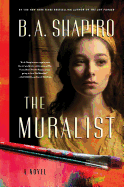
After The Art Forger, B.A. Shapiro reenters the world of art with The Muralist, a historical novel about the birth of the Abstract Expressionist movement. The Muralist is filled with avant-garde artists of the era like Pollock, de Kooning, Rothko and Krasner, but the novel is primarily centered on the fictional Alizée Benoit, who hung out with the others at the Village's Jumble Shop, and eventually convinced Eleanor Roosevelt to provide Works Progress Administration funding for two murals in the city. On the verge of fame, Benoit disappeared, leaving only rumors and two paintings inherited by her great-niece Dani Abrams, the novel's narrator. Dani lethargically works for an auction house among low-level cataloguers "with undergraduate art degrees from classy colleges and no real marketable skills." When a box of early unsigned Abstract Expressionist works is dropped at her cubicle to research and authenticate, Dani begins a quest to tie these paintings to her lost great-aunt and prove Benoit to be an early participant in the Abstract Expressionist art movement.
The Muralist is partly the study of the ravages of the Great Depression, the largesse of Roosevelt's WPA program and the politics of a largely isolationist U.S. population that was set against entry to millions of mostly Jewish refugees. It is also a story of the first indigenous American art style, a drama of family secrets in the wake of the Holocaust, and a passionate love story of Benoit and Rothko. A novel of art, romance, timely historical issues and family legacies, The Muralist smoothly bridges the literary/popular fiction gap. --Bruce Jacobs, founding partner, Watermark Books & Cafe, Wichita, Kan.

